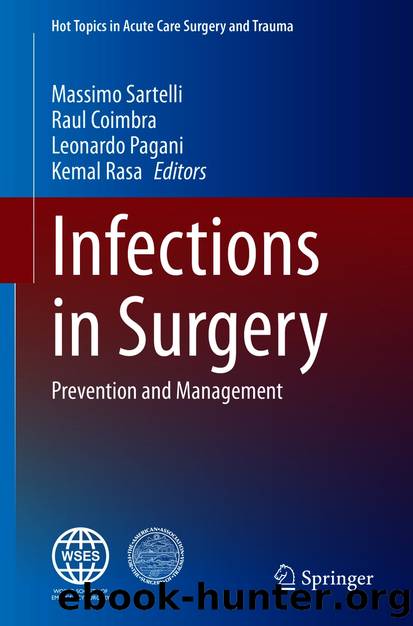Infections in Surgery by Unknown

Author:Unknown
Language: eng
Format: epub
ISBN: 9783030621162
Publisher: Springer International Publishing
13.5.2 Post Emergency Surgery Treatment
For abdominal sepsis that progresses or fails to improve after emergency laparotomy, there is a need for relaparotomy, based on the âon-demandâ relaparotomy strategy. Aggressive surgical approached such as radical peritoneal debridement and open abdomen treatment are associated with higher morbidity and mortality and should be abandoned [73â75]. Planned relaparotomy, where laparotomy is performed every 2 to 3 days until no intraperitoneal infection is observed, has lost popularity during the last decade. One RCT has compared planned relaparotomy with on-demand relaparotomy in patients with severe abdominal sepsis, and shows no significant difference in mortality and morbidity. However, using an on-demand strategy, a clear decrease in the number of laparotomies is seen as two-thirds of patients recovered without relaparotomy in the on-demand group, as well as shorter ICU stay and lower health care costs [76]. A strategy still popular is damage control surgery, adopted from trauma care where staged laparotomies with open abdomen are performed with the goal of treating immediate life-threatening causes, and delay of reconstructive surgery [77]. However, there is a lack of convincing evidence that damage control surgery is beneficial in non-trauma setting such as secondary peritonitis, and is therefore not preferable over on-demand treatment [8, 77]. On-demand treatment is a safe strategy and surgeons should strive for primary closure of the abdomen whenever possible. Primary open abdomen increases mortality [78]. When primary closure is not possible due to edema, the use of a temporary abdominal closure technique is recommended. A recent meta-analysis indicates that continuous mesh-mediated fascial traction with negative pressure therapy has the best results in terms of delayed closures and fistula rates [79]. Some fear abdominal compartment syndrome with progressive closure strategies, however with adequate ICU support and fluid management this is infrequently seen.
The decision to perform a relaparotomy remains difficult, since traditional scoring systems are inadequate for the prediction of ongoing peritonitis [80]. A recently developed and validated decision tool for ongoing abdominal sepsis may advise the surgeon on when to perform CT imaging in a patient who deteriorates or fails to progress [81, 82]. Furthermore, care should be provided by a multidisciplinary team with 24/7 decision making. Critically ill patients are admitted to an ICU facility with adequate set-up for complex patients (high-level ICU).
Download
This site does not store any files on its server. We only index and link to content provided by other sites. Please contact the content providers to delete copyright contents if any and email us, we'll remove relevant links or contents immediately.
| Administration & Medicine Economics | Allied Health Professions |
| Basic Sciences | Dentistry |
| History | Medical Informatics |
| Medicine | Nursing |
| Pharmacology | Psychology |
| Research | Veterinary Medicine |
Periodization Training for Sports by Tudor Bompa(8175)
Why We Sleep: Unlocking the Power of Sleep and Dreams by Matthew Walker(6620)
Paper Towns by Green John(5094)
The Immortal Life of Henrietta Lacks by Rebecca Skloot(4529)
The Sports Rules Book by Human Kinetics(4304)
Dynamic Alignment Through Imagery by Eric Franklin(4125)
ACSM's Complete Guide to Fitness & Health by ACSM(3992)
Kaplan MCAT Organic Chemistry Review: Created for MCAT 2015 (Kaplan Test Prep) by Kaplan(3942)
Introduction to Kinesiology by Shirl J. Hoffman(3728)
Livewired by David Eagleman(3688)
The Death of the Heart by Elizabeth Bowen(3555)
The River of Consciousness by Oliver Sacks(3543)
Alchemy and Alchemists by C. J. S. Thompson(3453)
Bad Pharma by Ben Goldacre(3359)
Descartes' Error by Antonio Damasio(3232)
The Emperor of All Maladies: A Biography of Cancer by Siddhartha Mukherjee(3072)
The Gene: An Intimate History by Siddhartha Mukherjee(3050)
The Fate of Rome: Climate, Disease, and the End of an Empire (The Princeton History of the Ancient World) by Kyle Harper(3007)
Kaplan MCAT Behavioral Sciences Review: Created for MCAT 2015 (Kaplan Test Prep) by Kaplan(2941)
